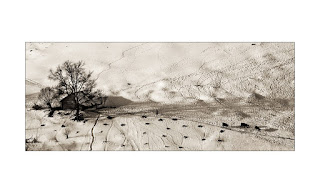Paul Evdokimov: „Este libertatea teribilă a oricărui artist de a reprezenta lumea după chipul sufletului său pustiit, mergând până la imaginea unei latrine imense unde colcăie monştri dezarticulaţi. [...] Odinioară, lucrurile puneau întrebări, ca într-o aşteptare, iar artistul le răspundea şi le făcea să trăiască din plin sub privirea sa creatoare, redându-le nevinovăţia feciorelnică, făcându-le să se întoarcă «acasă», către candoarea şi ingenuitatea lor. Artistul modern, înainte de a privi lumea, îşi întreabă sufletul şi aplică lucrurilor viziunea sa «dezintegrantă», se face complice la străvechea răzvrătire care vrea să scape în primul rând de Sens şi de orice principiu normativ. O asemenea reîntoarcere către haosul primordial accelerează uzura timpului şi restrânge fiinţa până la sărăcia nimicului. Materia se dizolvă şi îşi pierde contururile, este văzută în atomul atemporal a cărui durată a fost abolită, deci şi freamătul chipului viu, privirea încrezătoare. [...] Calea este întunecată, sufocantă, foarte nesigură în ce priveşte ieşirea. Pe de altă parte, omul, din punctul de vedere al lui Picasso şi al «liniei sale de cruzime», nu este cu nimic mai liniştitor. Probabil că aşa văd demonii lumea într-o optică ocultă şi în afara imaginii inaccesibile a lui Dumnezeu.
Nivelarea universală fărâmiţează Unicul, Ideea, Sacrul, şi îi înlocuieşte cu magia unei mişcări care se roteşte în jurul său, descentrată. Nu mai este eternitatea pe care păcatul a fragmentat-o în timp, este timpul fragmentat în neant.“
Brooks Jensen: „I see far too much of what I would consider pessimistic art, discouraging art, depressing art... photographic art that is intended to show us how bad the world is. You know, I don't need that. I know how bad the world is. [...] Now, that doesn't mean, you know, a blind eye to the world's ills. We don't need to be ostriches with our heads in the sand, but when it comes to art and the production of art and the enjoyment of art and surrounding ourselves with art, I continue to think that the purpose of art is to uplift the human spirit, not to discourage it. [...]
Artists are those people who are gifted to see what escapes other people's attention. In this regard, the historical role of the artist is to be more akin to the mystic than to the newspaper reporter, and if society at large has a tendency to see the negative, depressing, pessimistic, difficult, quote-unquote realistic side of life, then even more so the responsibility of artists is to show what can be, what could be, to show what is possible through the positive aspects of the human spirit, and to do so and to show and to illustrate what others may not be able to see because they are so surrounded by the difficulties of life. [...]
For me, it's those artists and those visions that encourage and motivate and try to illuminate the better side of the human spirit and those things that propel us to achieve and to demonstrate compassion and love and the positive aspects of life that are the ones that are the most interesting, most useful, most encouraging, most motivating. [...] The discouraging and the depressing is a copout ─ an easy path. It's much more difficult, both as an artist and as a human being, to stay focused on the positive in life, because that takes effort, and that's the way I choose to make my artwork and the way that it makes most sense to live my life.“
(Sublinierile mele, A. B.)







